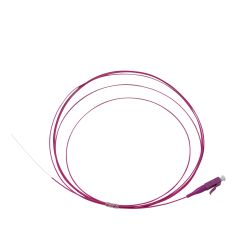Pigtail Patch Cord (900μm) OM4 Multimode FO for Indoor LSFH LC/PC 2m Televes
Pigtail Multi-Mode (MM)) fiber optic patch cord. It has one end pre-terminated with an LC/PC connector, and the other end without connector. This allows easy fusion of the pigtail against a fiber cable. The 900μm cover is LSFH type and is recommended for indoor use.
Pigtail Multi-Mode (MM)) fiber optic patch cord. It has one end pre-terminated with an LC/PC connector, and the other end without connector. This allows easy fusion of the pigtail against a fiber cable.
The 900μm cover is LSFH type and is recommended for indoor use.
Stands out for
- Multimode OM4 ITU-T G.651.1 fiber type
- LSFH sheath, magenta colour
- LC/PC connectors
- 2m long
Discover
Multimode fiber types
ultimode (MM) optical fiber is that which can transmit more than one light mode simultaneously, allowing multiple signals to be propagated at the same time. Its main advantage over single-mode (SM) fiber is the lower cost of both the fiber and the optical devices, making it an ideal solution for short distances, such as enterprise networks, communications rooms or data centers.
Multimode fiber cables are classified into 5 categories, called OM (Optical Multimode), from OM1 to OM5, and are mainly differentiated by their transmission speed in relation to distance.
The following table shows the distance that each category reaches according to the transmission speed:
| Category | Fast Ethernet | Gigabit Eth. | 10Gigabit Eth. | 40Gigabit Eth. | 100Gigabit Eth. |
| OM1 | 2000m | 275m | 33m | - | - |
| OM2 | 2000m | 550m | 82m | - | - |
| OM3 | 2000m | - | 300m | 100m | 70m |
| OM4 | 2000m | - | 550m | 150m | 150m |
| OM5 | - | - | 550m | 150m | 150m |
Additionally, multimode fibers differ in several factors:
- OM1 fibers have a core diameter of 62.5μm, while OM2, OM3, OM4 and OM5 fibers have a smaller core of 50μm
- OM1 and OM2 were the first to be developed. They are designed for use with LED light sources and are now tending towards disuse, as they are not suitable for high-speed networks. The next categories, OM3, OM4 and OM5, have been designed for use with laser emitters (VCSEL) achieving higher levels of bandwidth and speed
- OM3 and OM4 fibers work with 850 nm wavelengths, however, OM5 fiber has been optimized for WDM (Wave Division Multiplexing) applications. It is capable of transmitting up to 4 channels at higher wavelengths (880, 910 and 940 nm), obtaining a very high bandwidth
The following table summarizes the main characteristics of each type of multimode fiber:
| Category | Core/cladding diameter | Usual exterior color | Optical source | Bandwidth |
| OM1 | 65.2/125µm | Orange | LED | 200 MHz·km |
| OM2 | 50/125µm | Orange | LED | 500 MHz·km |
| OM3 | 50/125µm | Blue water | Laser (VCSEL) | 2000 MHz·km |
| OM4 | 50/125µm | Magenta | Laser (VCSEL) | 4700 MHz·km |
| OM5 | 50/125µm | Green lime | Laser (VCSEL) | 28000 MHz·km |
What is the difference between OM3 and OM4?
Among the different categories of multimode (MM) fiber, OM3 and OM4 fibers stand out as the most widely used today, since they achieve high transmission speed and bandwidth at an affordable price. OM4 fiber is an evolution of OM3, thanks to its improved internal construction, it has lower attenuation and thus manages to operate with a higher bandwidth than OM3, reaching greater distances.
Specifications
| Fiber core type | Multi-mode (ITU-T-G.651.1) | |
|---|---|---|
| Optical fiber type category | OM4 | |
| Fiber core diameter | μm | 50 |
| Fiber cladding diameter | μm | 125 |
| Coating buffer diameter | μm | 250 |
| Outer sheath Diameter | mm | 0.9 |
| Outer sheath Material | LSFH | |
| Blocking jelly | No | |
| Insertion losses in connector 1 | dB | < 0.3 |
| Return losses in connector 1 | dB | > 30 |
| Optical connector type 1 | LC | |
| Polishing type (Optical connector 1) | PC | |
| Minimum bending radius | mm | 4.5 |
| Operating temperature | °C | -20 ... 70 |
Summary
0
(0 Reviews)
Select a row below to filter reviews.
No customer reviews for the moment.



